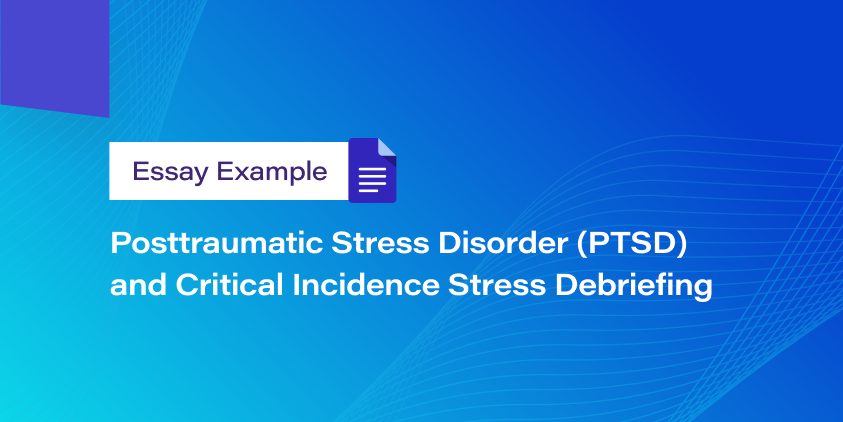Posttraumatic Stress Disorder and Critical Incidence Stress Debriefing

PTSD, commonly called Post-traumatic Stress Disorder, is a psychiatric disorder that occurs when one witnesses or experiences an event that may threaten life. The latter involves natural disasters, military combats, serious accidents, physical or sexual assault and terrorist incidents, among others. Most survivors of such trauma return to their normal life quickly. However, some of those who have PTSD can develop stress reactions that may not disappear without special treatment and may end up getting worse after a while. Individuals with PTSD often relive their experience through flashbacks and nightmares and may have difficulty sleeping. Such people often feel estranged or detached from the community and their normal lives. These symptoms may be long-lasting and severe enough to drastically impair the person’s daily life. Suffering from PTSD is characterized by three major types of symptoms.
When a person is identified as having a first set of symptoms, one relives the trauma in a manner that makes such an individual upset if confronting or thinking of the traumatic reminder. The other symptoms exhibited by people with PTSD – they stay away from persons or places that may remind them of the severe shock caused by an injury. They also tend to isolate themselves from the individuals surrounding them or try to make themselves feel numb. One more set of physical or mental changes caused by the indicated disorder involves such things as getting irritable, feeling on guard all the time or becoming startled easily. PTSD is noticeable through clear biological changes together with psychological symptoms. This disorder is often complicated because individuals suffering from it often develop additional disorders such as substance abuse, depression, memory and cognition problems, not forgetting other physical and mental health problems. PTSD also involves the impairment of a person’s ability to be well-functioned in a family or a social life. Moreover, this includes parenting difficulties, instability in terms of occupation, problems in the marital sphere, divorces, and family discords.
Critical Incidence Stress Debriefing
Studies reveal that psychological debriefing is an instantaneous or immediate intervention used on individuals who suffer from traumatic experiences. It purportedly aids persons in managing their stress reactions to the incident. Critical Incidence Stress Debriefing is best described as a process that limits or prevents the development of post-traumatic stress in individuals exposed to critical incidents. In the involved structured group story, the procedure combines practical information to normalize group members’ reactions to critical incidents and facilitate their recovery. The selection of CISD as a crisis intervention means that the traumatic event has already occurred, and the group member’s normal coping methods have been impaired or overwhelmed. Since CISD aims to enable people with trauma to return to their normal lives, the victims normally undergo three stress debriefing steps. The first step is defusing, where individuals are supplied with emergency contact numbers for them to call if they need to speak to someone regarding their feelings and symptoms. This first stage normally happens immediately after the traumatic incident. The second step is the debriefing itself. During this step, individuals in a group talk about their incidents and how they have affected them and their families. This encourages them to share their incident stories and, in addition, identify possible coping strategies. These people are also advised on how and ways of adopting their lifestyles following the event.
The third final step is a follow-up session that is usually brief and done the next day after the debriefing. During this session, individuals are assessed to ensure that they are coping well. They are also given contact information for additional counseling and support groups if needed. Supporters of CISD as a treatment for PTSD argue that it is an effective tool in enabling persons to cope with their impaired abilities to adapt to their before-the-incident lifestyles. Such supporters argue that the positive effects of psychotherapy on patients exceed the effects of no treatment at all, as well as placebo treatments for various conditions such as anxiety disorders, mood disorders, and depression. Those refuting this treatment argue that it is a psychological treatment that may lead to more harm than good done to an individual as a psychotherapy tool. Lilienfeld (2011) asserts that the deterioration effect is one outcome of the psychotherapy treatment observed over the years. According to Lilienfeld (2011), 3 to 6% of patients become worse following psychotherapy.
In addition, Boisvert and Faust (2003) support this statement by stating that approximately 10% of clients get worse after therapy. The other reason given for refuting this treatment is that it has a negative effect size in its meta-analysis. From a professional opinion, I believe that CISD is an appropriate treatment for PTSD as it is a safe, easy, and efficient method:
- CISD is a process with various steps and phases, enabling individuals to go at their own pace.
- It is an early intervention treatment that supports the recovery of individuals through group support and counseling.
- The happening in CISD sessions are always confidential and under the supervision of a professional mental health doctor.
Alternative Treatment
Apart from CISD, there are other alternative treatments for PTSD. One of them includes the cognitive restricting method. The latter, also known as Trauma-Focused Cognitive Behavioral Therapy, involves the careful and gradual exposure of individuals to thoughts, feelings, and situations that remind them of the traumatic incident. This therapy identifies upsetting thoughts about the event, particularly those that are distorted and irrational. The patient is encouraged to replace these upsetting thoughts with more balanced pictures to overcome the trauma. This therapy is often difficult and painful for victims; however, its results have proved effective and efficient.
📎 References:
1. Boisvert, C. M., & Faust, D. (2003). Leading researchers’ consensus on psychotherapy research findings: Implications for the teaching and conduct of psychotherapy. Professional Psychology: Research and Practice, 34(5), 508–513.
2. Lilienfeld, S. O. (2007). Psychological treatments that cause harm. Perspectives on Psychological Science, 2(1), 53-70.
